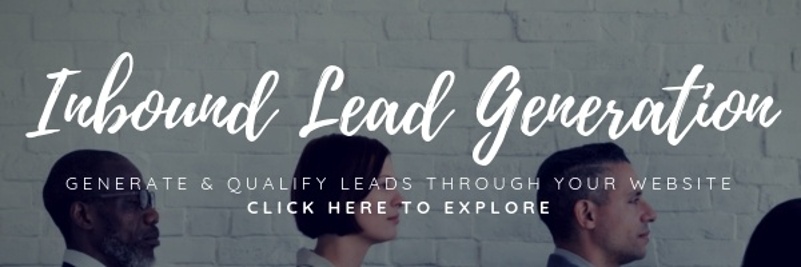Are you trying to update your b2b marketing plan to include inbound lead generation?
Are you tired of investing in marketing or spending time developing content that doesn't generate tangible outcomes?
These b2b lead generation practices will help you turn your website into your best source for new opportunities, while ensuring sales doesn't squander viable deals before they become viable deals.
The mechanics of b2b lead generation:
Before breaking ground on best practices, let's talk about what it is first. There are many names for it, but we like the moniker, "inbound marketing," because it helps us separate what we're doing from the run-of-the-mill cold list plays.
There are really 2 parts to generating quality inbound b2b leads:
- Attraction - get strangers to visit your website
- Conversion - get visitors to hand over their contact information
These are the two very basic principles. However, there is a lot more to executing a "successful" program than piling leads into the laps of your salespeople. Additionally, earning that conversion isn't as simple as posting a form and holding your breath.
You'll know this if you've ever run paid ads. Sure, your traffic reports light up, but traffic reports don't pay the bills... do they? (read the article: What is Inbound Lead Generation?)
Here are your 5 best practices for generating awesome leads that convert to awesome customers:
1. Core Strategy & Alignment
How much do you really know about your customers' buying habits?
To many, revisiting core strategy and alignment feels like taking a step backwards. After all, we're constructing foundational building blocks at this stage, which means in many ways that we're scrapping what you think you know about your customers, and replacing it with something that can feel quite new.
But this step is absolutely critical.
As much you know about your customers from your daily interaction, you're likely not asking the same questions we would ask in an interview designed to extrapolate strategic information that feeds your lead gen efforts.
Additionally, the goals of sales and marketing have historically been separated, but technology and the internet are bringing the two closer together, and in reality, they have shared goals today.
Here is where I recommend you find clarity before building out your core strategy, and aligning your sales & marketing efforts:
- Buyer persona development (demographics, roles, titles, challenges, where they get info)
- Buyer profile development (ideal and non-ideal traits for the businesses you're targeting)
- Deal stage and entrance criteria architecture
- Lead definitions (the differences between leads, MQLs, and SQLs)
- Inbound sales treatment architecture
- Response time commitments based on lead definitions
This is a collaborative process. Once complete, I would put everything into a Service Level Agreement (SLA), and get signatures from all key leaders involved (sales, marketing, and your marketing partners)
2. Sales Infrastructure Update/Implementation
We're still not talking about the inbound mechanism - and for good reason. Without the proper sales treatment and accountability standards and tools in place, you're not driving successful outcomes. You're still just putting out something and hoping for the best.
I suggest implementing a modrn CRM like Hubspot Sales Pro or Enterprise (read the sales guy review here). This will give you a better handle on what's happening, while providing tools that support sales in their shared mission of putting more money to your bottom line.
Keep in mind - Leads mean NOTHING unless they generate closed deals. So, rather than hoping for the best, implement a technology that ensures your best foot forward while creating an environment for transparency and accountability.
Another key aspect to sales infrastructure is integrating it with your marketing tools, and elevating insights to sales when they are most valuable.
Sales alerts are key. For example, when somebody visits your pricing page or something that indicates that they are ready to buy or talk about buying, somebody should be getting an alert letting them know, so they can connect with them within 5-minutes of that engaging behavior.
3. Building The Inbound Mousetrap
As any good b2b marketing strategy, a strong content marketing strategy will be original. While yes, you may end up emulating something that already exists in order to minimize risk of putting too many eggs in an untested basket, it should still speak to the individual.
We do an exercise called "Journey Mapping." This involves going through each stage of the buyer's journey, and extrapolating the positive and negative triggers that would lead somebody to finding your website to begin with.
For example, at the Top of the Funnel (TOFU or Awareness stage), your visitors are going to be diagnosing their problems, not looking for specific solutions just yet.
For my management consulting firm client that helps small businesses raise capital through venture funding, a positive trigger could be that sales is growing faster than production, so they need a cash infusion. They might run any one of these searches:
- How do I find investors?
- Raise capital
- How to raise capital for business expansion
Once they identify a couple of different options that seem viable, they'll enter the Middle of Funnel (MOFU or Consideration stage). Their search queries will be more specific in nature, such as:
- How to raise venture capital
- Types of venture capital
- Venture capital firms
Once they settle on a couple of different solutions, their queries are going to change again - and they may look something like this:
- How to pitch a VC
- VC pitch deck
As you go through the journey mapping, you can see where the offers jump out at you, and the supporting blogs and email titles as well.
We're able to map out a prospect's journey, because we've asked them strategic questions during the interview process, and the persona itself is ripe with information.
4. Publishing the Mousetrap
Offer -
- Gate it behind a form on an SEO-rich landing page (there should be no menus in the header and footer, and no other action available outside of submitting the form to gain access to it)
- Host it on a separate thank you page (add back the menus, and provide next step based on where they are in the funnel. If this is a TOFU offer, lead them to a MOFU offer next)
- Kick out an email immediately after they download - include the link and the next step
Blogs -
- Get on a regular schedule (weekly, monthly, etc)
- Make sure to include a nice button and links that lead to the offer when it's relevant
- Frame them around keywords related to the offer
- Publish them on social media
Emails -
- Send an email blast to your existing database to get them to "opt in" to your new progream
- Set up a series of emails to nurture leads after they gain access to your offer
5. Getting eyes on the prize
While your lead generation program WILL eventually garner traffic because of the fact that you'll have posted it on an SEO-rich landing page, and support it with SEO-rich blog posts, you're going to want to drive as much traffic as reasonably possible to it.
There are a few ways to do this:
- Email opt-in blast
- Social media marketing (content sharing on LinkedIn, Facebook, Twitter, etc)
- PPC ads
CONCLUSION:
Successful b2b lead generation comes from careful planning and thoughtful execution. You're solving problems, and providing value along the way.
Click HERE to learn more about our B2b Lead Generation Services:



